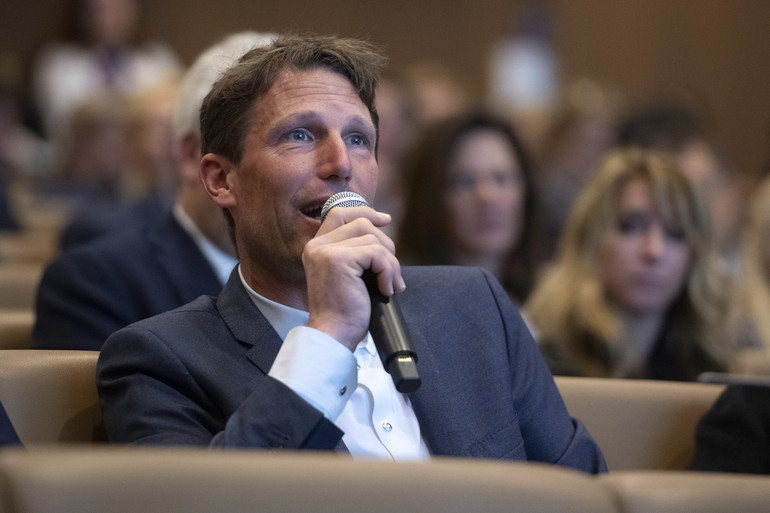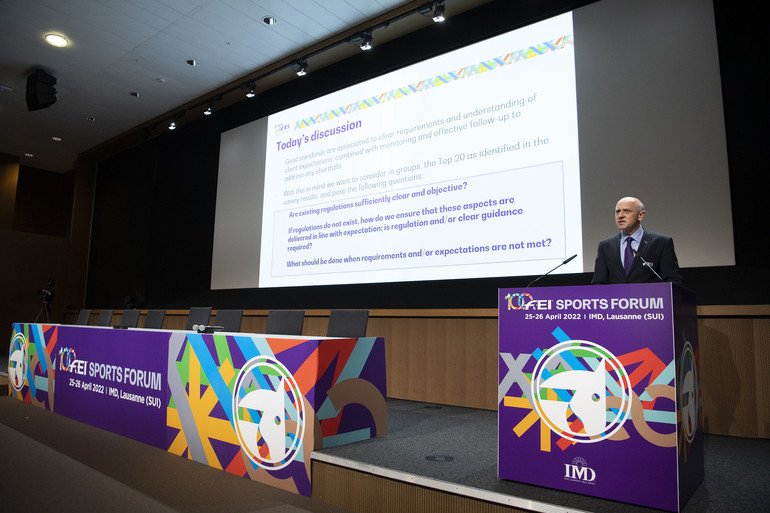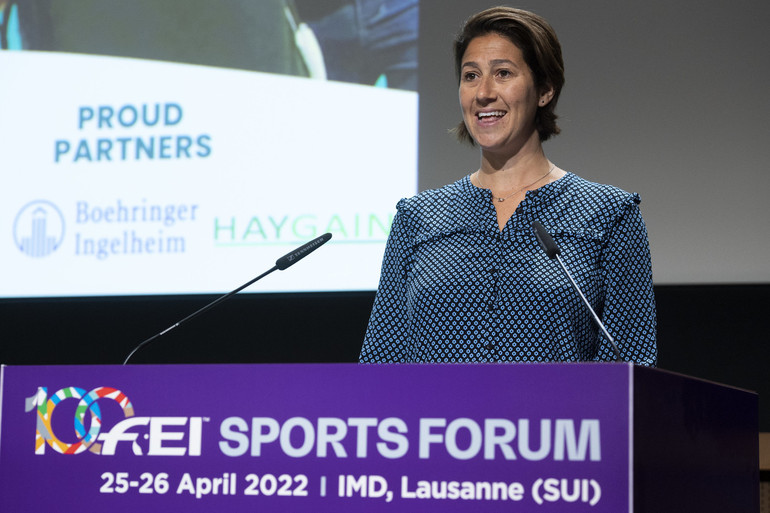The FEI Sports Forum 2022 continued on Tuesday, in Lausanne, Switzerland, and session nr. seven was dedicated to the FEI Event Standards project. The project goes back to the discussions during the Jumping Round Table meeting in Lausanne during the summer of 2019, where it was agreed that stronger requirements are important for improving the overall standard of FEI events, particularly regarding aspects of stabling, security and bio-security.
Tim Hadaway, FEI Director Games and Operations, presented the FEI Event Standards project and the key findings of a stakeholder survey. “We believe that good standards result from clear requirements, an understanding of our clients’ expectations combined with an effective system or systems in monitoring and follow-up when we identify any shortfalls in delivery,” Hadaway said.
In the discipline of jumping, the top 10 aspects of concern in all stakeholder groups (grooms, riders, officials, etc.) were according to the FEI’s survey:
- WIFI access, screen(s) covering FoP, running order, and results
- Access to power points
- Lunging area (size, lay-out)
- Wash areas (number of places, water pressure)
- Refreshments in the stable area
- Isle width
- Ventilation, lightning and temperature control
- Overall security and access control
- Footing in the stable area (firm, even, rubber mats if needed)
- Showers (number, location, warm water availability)
Dividing the top 20 aspects of the survey into five groups – security and access control; training and exercise provisions; stabling provisions; event facilities and services; cleanliness and biosecurity – Hadaway then opened the floor for discussion, asking for focus on three main questions:
- Are existing regulations sufficiently clear and objective?
- If regulations do not exist, how do we ensure that these aspects are delivered in line with expectations? Is regulation and/or clear guidance required?
- What should be done when requirements and/or expectations are not met?
Security and access control: A lot to improve
The security and access control at FEI events was a topic many of the participants were concerned about, and IJRC President Kevin Staut was one of those present that shared his experience. “We have a big gap between the top shows – let’s say 4* and 5* – and the smaller ones,” Staut said. “Access at the top shows is really controlled, where I think it is well managed. But also at the top shows, what you want to show to your sponsors or a few people, is the backstage so you give accreditation to those that are the whole day at the VIP and they come with the kids, which I also understand is important for the show organisers – to show what’s going on behind the scenes.”
“Honestly, there are too many people who have access to the stable, who have nothing to do there.That is a problem for the bigger shows. It’s true that at many 2* and 3* shows – even if you have accreditations per rules and on paper – everybody can go in,” Staut said. “Now that you signed the MoU with the IGA, you can also speak straight with the grooms – how difficult it is for them, to manage the flow of people coming all the time, and taking care of the horses. First of all, their own security, but also to find time for them to rest before or after the competitions, to have the best atmosphere you need to reach to compete and to be safe.”
Honestly, there are too many people who have access to the stable, who have nothing to do there
“For the top shows, I know the people who are coming to visit for a few minutes the stables are assisted by stewards and it is well done, but sometimes you see some kid with candy or chocolate, and they try to give it to the horses – and it is really, really complicated for us to manage that,” Staut pointed out.
Peter Bollen, Chair of the International Equestrian Organizers Alliance, commented on the results from the survey, and said: “Let me first say in general: from the organizers’ side, we were very surprised by the outcome of the survey. It was almost ironic to us that WIFI is the most important item on the shows, where you see for example that footing was only at place ten. So, we don’t know who was answering the survey, or were the questions right – we were very surprised with what came out of the survey. Also, for the organizers; really important items that have been on the table for the last twenty years, we don’t see in the survey, like the link to the event classification system and the star level, better officials – it does not come out of the survey. Let me say: I think there is work to do to do this survey better.”
As to the stable security, Bollen agreed with some of Staut’s points. “I agree a little bit Kevin, that at the 4* and 5* shows the security is most of the time pretty ok – of course there are challenges, and we need to find solutions for those. But the issue is mainly at the 2* and 3* shows where often we can walk into the stables whenever you want, and also in the tours, I would say it is the same issue there, there is no security at all. So, there is a big job to do. Those organizers also need to follow the rules, and we need to control them better. I would say it is not really an issue of cost or people; it just has to be done. The requirement is the same for the 2* and 3* shows as the higher-level shows, so I think we need to control it better, push better on it and force them to have a better stable control – because it is true that often, there are really dangerous situations in the stables that might cause accidents.”
It is true that often, there are really dangerous situations in the stables that might cause accidents
Swedish dressage rider Patrik Kittel came to Lausanne having done his homework on stable security. “I did a little survey myself to see about the stable security, so I challenged the security a bit,” Kittel said. “From eight shows, four shows I went in and out with no one checking me, so that is 50%. Two shows, which one of them was a very high show, I got checked seven times from ten, so three times I walked straight through. Also, at this show, I found two accesses to the main stable that was open, where you could go in and out without anyone checking, and two shows, I have to say there was full security, where they checked me every time, checked my accreditation, looked me in the eyes, saw that I was actually the same person walking in. So, there is definitely something to do here, as Kevin mentioned, the fear for doping contamination as a rider is extremely high and no matter if you are found not guilty in the end, the stamp that you doped a horse is already there. And it is always with the fear that we riders enter a show, and the stable security is something that is lacking – I am sorry, it does need a lot of improvement, also in the higher shows.”
Training and exercise provisions: One size does not fit all
As to provisions for training and exercise areas at FEI events, Michael Stone – president of Equestrian Sport Productions – said: “I think the key thing that comes out of the survey is the huge difference in events, not only around the world – but even events like Thomas’ [Gothenburg Horse Show] where he does three-four disciplines all indoors and we do a huge national show and a very big FEI show. Every one of them has challenges. Organizers in general realise they need the top riders to be successful. The only way to get the top riders, is if you keep working hard to make the shows better, provide better stabling, provide better arenas, better footing. And I think the vast majority of organizers, especially at the top level, try very hard to do that. But obviously, there is a financial constrains as well. Often, it is easy to sit in Lausanne and say let’s just make this rule, without thinking that some organizer out there, is going to have to invest 50-60 thousand in a new IT system to provide something that the FEI may think is easy. But I think things have improved enormously and there is communication. But, one size doesn’t fit all and I think that’s where any of these rules and regulations need to be thought out very carefully before they are implemented, because what works in the States – where we are very strict on stable security for example – would not work in Australia. I think that is the most important thing that everyone needs to realise; you just can’t say ‘well, this is it for everyone’.”
One size doesn’t fit all and I think that’s where any of these rules and regulations need to be thought out very carefully before they are implemented
Kevin Staut was specific in his wishes and pointed out: “I think it is really important to have a regulation – especially for indoor shows with many disciplines and a lot of audience, running the different competitions to keep everybody happy – that the first one of the competition has access to a warm-up or to a place to start to warm the horse at least one hour before the beginning of the class. And then the last combination also needs to have access to a place to trot, to walk the horse for 30 minutes after the end of the class.”
Stabling provisions: Standards vary hugely
Access to power points, wash areas, ventilation, lighting and temperature, footing in the stable area, storage, as well as isle width – specifications regulated in the FEI Veterinary Regulations 1008 – were the main issues identified in the survey for the stabling areas at FEI events.
“The stabling standards vary hugely, and something needs to be addressed regarding this. Last year we went from bespoke, indoor, permanent, air-conditioned stabling to a month later arriving to the Europeans to find the same horses being stabled in vinyl, temporary, stables, in a tent with limited electricity so we were not allowed fans to help deal with the heat and the bad fly situation,” Alan Davies – groom for Carl Hester and Charlotte Dujardin – pointed out via Lucy Katan, founding director of the International Grooms Association. Other issues pointed out by the IGA were cleaning of the muck/waste areas, lack of space for the horses and other safety issues.
The stabling standards vary hugely, and something needs to be addressed regarding this
“I think especially the indoor shows, they have to work with the constrains that they have,” Peter Bollen said. “We look for fantastic arenas where we can put a lot of public, to promote our sport, but often in these places, it is not always easy to build stables, so we do what we can to make it is as good as possible. But there is often limitations on the locations we have, mostly at the indoor shows – outdoor is a little bit easier. Everybody – riders and grooms – need to understand that often, we try to do it as good as possible, but of course it needs to be good enough for the horses and the grooms also.”
FEI Veterinary Director Dr Göran Åkerström pointed out how inventing own solutions to problems can get dangerous. “One thing I would like to address in regards of electricity, is if in summertime electricity is not properly provided in the stables and it is hot, people will find their own solutions. I have documented several venues where extremely dangerous private solutions on how to get electricity to the fans for their horses and that really needs to be focused on, especially outdoors. I think it is even bigger problem when you have those situations, because horses and people can actually die from that.”
Event facilities and services: Small improvements can make a big difference
Improving event facilities and services, especially for the grooms who work extremely long hours at international shows, was also subject of discussions. “I think there is an element of promoting better practice,” Tim Hadaway said. “You find the right way of looking after the groom, everything follows from that: You got a happy groom, you got a happy athlete, you got a happy athlete, you got a happy chef d’equipe – the whole thing can be a lot smoother. It is a very simple philosophy I’ve held on to."
“Through promotion of best practice, I think there is a lot that can be done that doesn’t need to cost a fortune,” Hadaway added.
Lucy Katan, of the International Grooms Association, pointed out how small improvements can make a big difference. “Grooms work really hard, they work long hours,” Katan said. “Simply, as long as they can get a cup of coffee or tea for free, on the edge of the stables or in the stable area, they can get some food easily and they can have a warm, hot shower which is pleasant enough, that is acceptable, and they can get on their all-important WIFI – because imagine, they are stuck in the stable for the vast majority of the day – as long as all of those are there, I think we will get a tick and a thumbs up from them. I think there can be creativity and a lot of these things can be resolved for the grooms and their complaints will come through now as they have the voice, but a lot of them can be resolved with creativity and they aren’t necessarily expensive to resolve.”
A lot that can be done that doesn’t need to cost a fortune
“I find it very sad that 20 years ago, I was an international dressage groom and I remember watching my rider who enjoyed the hospitality, disappearing to the hospitality to have his good food and his glass of wine, whereas I was in the stables and I couldn’t even get a cup of coffee," Katan said. "And I find it very sad that actually in some circumstances, that hasn’t changed in 20 years and that I think need to be resolved urgently.”
Following the Sports Forum, the FEI will consider the complete list in context of the discussions and come up with comprehensive proposals that will be shared for final consultation so that an implementation plan can be developed.
Click here to watch the different sessions at the FEI Sports Forum 2022.














